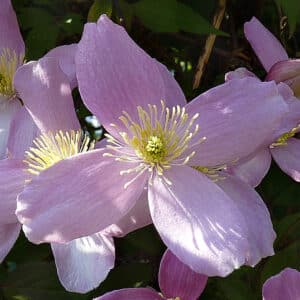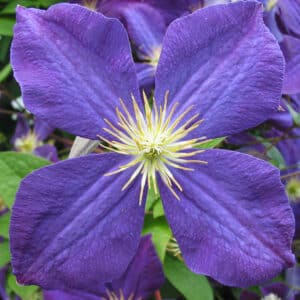Clematis Pruning 101: Group 1, 2, and 3 Explained
Clematis is a beloved flowering vine known for its vibrant colors, climbing nature, and long blooming season. However, pruning clematis properly is essential for vigorous growth and consistent flowering. Clematis are divided into three main pruning groups based on their blooming time and growth habits: Group 1, Group 2, and Group 3. Knowing which group your clematis belongs to will help you determine the correct time and method for pruning.
Group 1: Spring Bloomers
When to Prune
Group 1 clematis bloom early in the season on old wood, meaning the buds for spring blooms are formed on growth from the previous year. These clematis varieties should be pruned immediately after flowering, usually in late spring or early summer. Pruning too late in the season will remove next year’s flower buds.
How to Prune
Pruning is generally minimal for Group 1 clematis. Remove any dead or weak stems and lightly shape the plant to control size and encourage airflow. Avoid heavy cutting unless the plant has become too large or tangled. If rejuvenation is needed, cut back one-third of the oldest stems to the base over a few seasons.
Why Prune at This Time
Pruning after flowering allows the plant to maintain its natural structure and ensures that flower buds for the following year remain intact.
Common Varieties in Group 1
- Clematis montana (e.g., ‘Rubens’, ‘Elizabeth’)
- Clematis alpina (e.g., ‘Blue Dancer’, ‘Frances Rivis’)
- Clematis macropetala (e.g., ‘Markham’s Pink’)
These are vigorous growers that can cover arbors, fences, or pergolas quickly with masses of small, often fragrant blooms in early spring.
Group 2: Repeat Bloomers
When to Prune
Group 2 clematis bloom in late spring to early summer on old wood and then may rebloom in late summer on new growth. These should be lightly pruned in late winter or early spring to remove weak or dead stems, and again after the first flush of flowers to encourage a second bloom.
How to Prune
In early spring, remove any dead or damaged stems down to a pair of strong buds. For mature plants, you can thin out tangled growth to improve airflow. After the first round of flowers has faded, trim back flowering stems by about one-third to a pair of healthy buds to stimulate new flowering shoots.
Why Prune at This Time
Light pruning in early spring preserves buds on old wood for the initial bloom, while trimming after flowering encourages a second wave of flowers on new growth.
Common Varieties in Group 2
- Clematis ‘Nelly Moser’
- Clematis ‘Henryi’
- Clematis ‘Miss Bateman’
- Clematis ‘The President’
These varieties typically have large, showy flowers and benefit from gentle shaping and removal of dead material to keep them tidy and blooming well into the season.
Group 3: Summer/Fall Bloomers
When to Prune
Group 3 clematis flower on new growth and bloom in mid to late summer into fall. These should be pruned in late winter or early spring, before the plant begins to leaf out.
How to Prune
Cut all stems back to about 12–18 inches above ground level, leaving a few healthy buds on each stem. This type of hard pruning encourages vigorous new growth, which is where flowers will appear later in the season.
Why Prune at This Time
Since these clematis bloom on current season’s growth, pruning them hard in early spring helps the plant focus energy on fresh shoots, resulting in larger and more abundant blooms.
Common Varieties in Group 3
- Clematis ‘Jackmanii’
- Clematis ‘Sweet Autumn’ (C. terniflora)
- Clematis ‘Etoile Violette’
- Clematis ‘Ville de Lyon’
- Clematis ‘Rouge Cardinal’
These varieties often have prolific bloom displays and can grow quite vigorously during the season. They respond well to annual hard pruning.
Identifying Your Clematis Group
If you’re unsure which group your clematis belongs to, observe its blooming habits:
- If it blooms in early spring and doesn’t flower again, it’s likely Group 1.
- If it blooms in late spring and reblooms in summer, it’s likely Group 2.
- If it blooms only in late summer or fall, it’s Group 3.
For new or unknown plants, it’s best to allow one full growing season before pruning to observe its bloom time and growth pattern.
Final Tips for Clematis Pruning Success
- Always use sharp, clean pruning shears to make clean cuts and avoid spreading disease.
- When in doubt, prune less. Over-pruning can reduce flowering in Group 1 and Group 2 plants.
- Apply mulch after pruning to conserve moisture and suppress weeds.
- Feed clematis with a balanced fertilizer after pruning to promote strong growth and blooms.
Understanding the proper pruning group of your clematis is key to keeping it healthy, well-shaped, and covered in flowers year after year.















